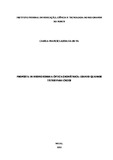Proposta de ensino sobre óptica geométrica: usando quadros táteis para cegos

Visualizar/
Data
2022-08-25Autor
Silva, Camila Francicláudia da
http://lattes.cnpq.br/5947607331473557
Metadado
Mostrar registro completoResumo
The teaching proposal is aimed at high school physics teachers who have blind students in
their classes. The goal is to propose a didactic sequence that will serve as a basis for the
teacher to systematize the contents of Geometric Optics. To achieve this goal, tactile pictures
were prepared to provide sensory and memory experiences for the students. In addition,
Vygotsky's sociointeractionist approach is used to promote the development of teaching and
learning. These boards are divided into five themes: the occurrence of vision, rays and beams
of light, optical media, principles of geometric optics, and visual angle. To assemble the
boards, we chose low-cost materials. These boards have dimensions that facilitate handling
and demand little effort in their locomotion. The materials have different textures, rough or
smooth. As for thickness, they can be thin or thick. These characteristics make these
materials excellent tactile stimulators. The exhibition of these paintings in the classroom can
be divided into two previous steps: in the first, the teacher will give a description of the
paintings, informing the materials used and how they are organized so that the student can
build the scenario; in the second, the teacher gives the student the experience of handling the
paintings, which will contribute to familiarization with the material used. The third step will
take place during the class in which the teacher will make the material available in a
sequential manner so that the student can follow the class as the content advances. It is
expected that with the use of tactile boards in the classroom it will be possible to build
knowledge, thus promoting an inclusive education.



